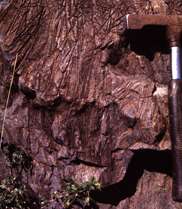Extraterrestrial platinum was 'stirred' into the Earth

(PhysOrg.com) -- A research program aimed at using platinum as an exploration guide for nickel has for the first time been able to put a time scale on the planet’s large-scale convection processes.
The research is reported in a Nature paper titled “Progressive mixing of meteoritic veneer into the early Earth’s deep mantle”.
Report author CSIRO Minerals Down Under Flagship researcher Dr Stephen Barnes said the study group collected a large body of data on the platinum content of lava flows called komatiites, which host some of the world’s major nickel deposits.
“We found that the oldest komatiites have the lowest platinum content,” Dr Barnes said.
“The platinum content gradually increases from about 3.5 billion years to 2.9 billion years ago.
“This tells us that the deep source where the komatiite came from, down near the boundary between the Earth’s core and mantle, was gradually gaining platinum over time”.
The paper’s authors now think they know why.
“When the Earth’s core formed, it took all the available platinum with it, leaving the mantle and crust with none,” Dr Barnes said.
“Following that, a steady rain of meteorites created the so-called Late Veneer - a thin surface layer of meteorite debris rich in platinum.”
With time through large-scale convection processes, which now cause plate tectonics, this material was stirred down into the interior of the Earth.
We are seeing the signal of that stirring, which took about 1.5 billion years to occur.
This is the first time a time scale has been put on the stirring, which has important implications for the people who study the dynamics of mantle processes and the mechanisms that cause plate tectonics, earthquakes and volcanoes.
Combined with some other work by the researchers on sister elements to platinum, iridium and osmium, we also now have a new framework for understanding the variations in isotopic ratios of osmium with time.
Osmium isotopes are widely used as tracers of mantle processes, but there has been a mismatch between signals from osmium and from other important isotopic tracer systems which has eluded explanation until now.
Co-authors Dr Marco Fiorentini and Dr Wolfgang Maier from the University of Western Australia are delighted that this is a completely academic outcome which came out of an industry-funded project.
“It is a nice example of an unexpected fundamental discovery arising from a practical applied science study and demonstrates the very positive collaborations that exist between CSIRO and the University of Western Australia,” Dr Fiorentini said.
Provided by CSIRO (news : web)


















